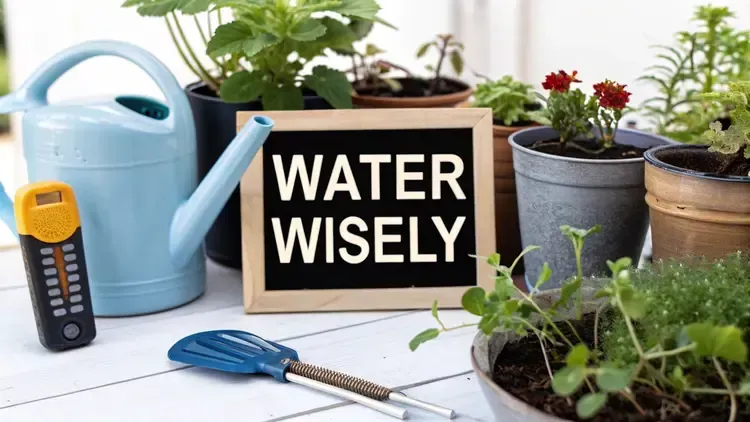
How Often Should I Water Plants? Tips for Healthy Gardens
How Often Should I Water Plants? Tips for Healthy Gardens
If you ask ten different gardeners "how often should I water my plants?" you might get ten different answers. But if you ask an experienced one, they'll probably tell you the same thing: ditch the fixed schedule.
The single biggest mistake new plant owners make is watering on a rigid calendar—every Sunday, like clockwork. This approach often leads to the #1 plant killer: overwatering. The real golden rule is much simpler and far more effective: water only when your plant actually needs it. And the best way to know that is to check the soil.

The Golden Rule of Watering Plants
Think of your plant's soil like a sponge. When it's completely soaked, there's no room for air. Roots need oxygen to breathe, and without it, they suffocate and begin to rot. Letting the soil dry out a bit between waterings creates essential air pockets that encourage strong, healthy roots to grow in search of moisture.
For most common houseplants, this means waiting until the top one to two inches of soil feel dry to the touch. It's a simple, intuitive check that connects you to your plant's real-time needs, rather than relying on a guess.
If you want to eliminate the guesswork from the touch test, a simple soil moisture meter can provide an instant reading, so you’ll always know exactly when your plants need water.
Matching Water to Plant Type
Of course, "when the soil is dry" means different things to different plants. A succulent from a bone-dry desert and a fern from a humid rainforest floor have completely different ideas about thirst. Understanding where your plant comes from is the key to getting its watering routine right.
Succulents and Cacti: These desert natives are built to store water in their leaves and stems. They've adapted to long droughts and prefer their soil to dry out completely between waterings.
Tropical Plants (like Monsteras or Ferns): Coming from environments with frequent rain, these plants like more consistent moisture. They don't want to be soggy, but they also don't want to dry out entirely.
Foliage Plants (like Pothos or Snake Plants): Many of these common houseplants are quite adaptable. They're happy to dry out some, but don't like to be left thirsty for too long.
This is why a one-size-fits-all schedule just doesn't work. A weekly watering routine might be perfect for a thirsty fern but would quickly spell death for a cactus.

To make it even easier, here’s a quick reference table to help you gauge how dry the soil should be for different types of plants before you reach for the watering can.
Quick Guide to Soil Dryness Before Watering

This table is a great starting point. Your specific conditions—like light, pot size, and humidity—will also play a role, but this gives you a solid framework for keeping your plants happy.
The Importance of Consistency for Young Plants
There is one major exception to the "let it dry out" rule: young seedlings. For seeds to germinate and for tiny new plants to establish their roots, they need consistent moisture.
In fact, studies have shown that daily watering leads to the fastest seed emergence and the development of healthier, longer shoots in young plants. Watering just every few days, in contrast, can delay growth significantly. You can discover more about how watering frequency impacts early growth if you want to dive into the science.
The key is to keep the soil for seedlings consistently moist, but never waterlogged.
Key Takeaway: If you don't have a moisture monitor, the "touch test" is your most reliable tool. Stick your finger about two inches into the soil. If it feels dry, it's time to water. If it's still damp, wait a few more days and check again. This intuitive approach will give you the confidence to provide perfect care every time.
Decoding Your Plant's Thirst Signals
Your plants are always talking to you... The trick is learning to speak their language. Instead of sticking to a rigid calendar, you can learn to read the clear visual cues that signal thirst. Catch them early, and you can give your plants a drink long before any real harm is done. This shifts your whole approach from a guessing game to a genuine conversation with your greenery.
Think of a plant's cells like tiny water balloons. When they're full, the leaves and stems stand firm and proud. But when water runs low, those cells start to deflate. That's when you see the most common sign of a thirsty plant: soft, wilting, or drooping leaves. It’s often the first and most dramatic signal your plant sends out.
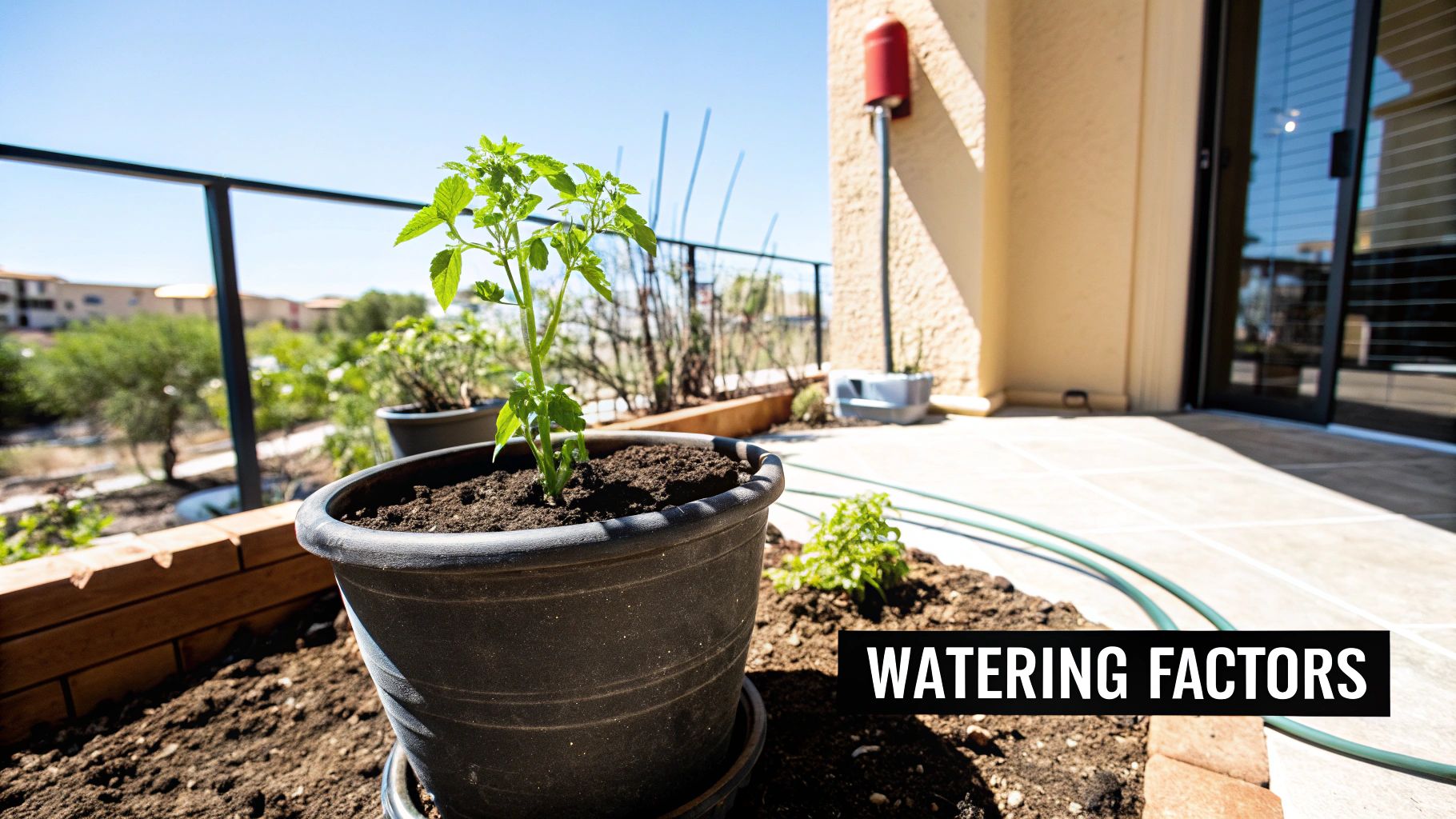
Underwatering vs. Overwatering Cues
Here’s where a lot of people get tripped up. It’s absolutely crucial to tell the difference between a thirsty plant and a drowning one, because some of the signs look surprisingly similar. A quick check of the soil and a closer look at the plant, however, will always reveal the truth. Getting this right is the key to a solid watering routine.
Signs of an Underwatered Plant:
Wilting or Limp Leaves: The plant looks sad and droopy, but the leaves feel soft, not mushy.
Crispy, Brown Edges: Leaf tips and edges might turn brown and feel brittle to the touch.
Dry, Compacted Soil: The soil is bone-dry and may even pull away from the sides of the pot.
Stunted Growth: New leaves may come in smaller than usual, or growth might just stop altogether.
Signs of an Overwatered Plant:
Yellowing Leaves: This often starts with the lower leaves, which turn yellow and might fall off easily.
Mushy Stems: The base of the plant feels soft, squishy, or even black—a classic sign of root rot.
Soggy Soil: The soil stays wet for days after watering and might even have a musty smell.
Wilting with Wet Soil: This is the most confusing one. Overwatered plants can also wilt because their rotting roots can no longer absorb water.

By learning to spot these cues, you become a proactive plant parent. You’re not just following a calendar; you’re responding to the direct, real-time needs of your plant, ensuring it gets the right amount of water precisely when it’s needed.
Ultimately, mastering these signals is the most reliable way to know how often you should water your plants. Once you pair this knowledge with the simple "touch test," you'll build the confidence to provide perfect hydration every single time.
How Soil And Pots Control Your Watering Routine
Ever wonder why two identical plants in your home might need a drink on completely different schedules? The secret isn’t in the plant itself, but in its foundation. The soil it lives in and the pot that holds it. These two elements team up to control the moisture available to your plant's roots, and getting them right is a game-changer.
Think of your soil mix like a sponge. A sandy, gritty mix is like a porous sea sponge; water zips right through, and it dries out in a flash. This is exactly what succulents and cacti need, since they can't stand having “wet feet.” On the other hand, a rich, dark soil loaded with compost is more like a dense kitchen sponge. It soaks up water and holds onto it for much longer, which is perfect for thirsty tropicals that crave steady moisture.
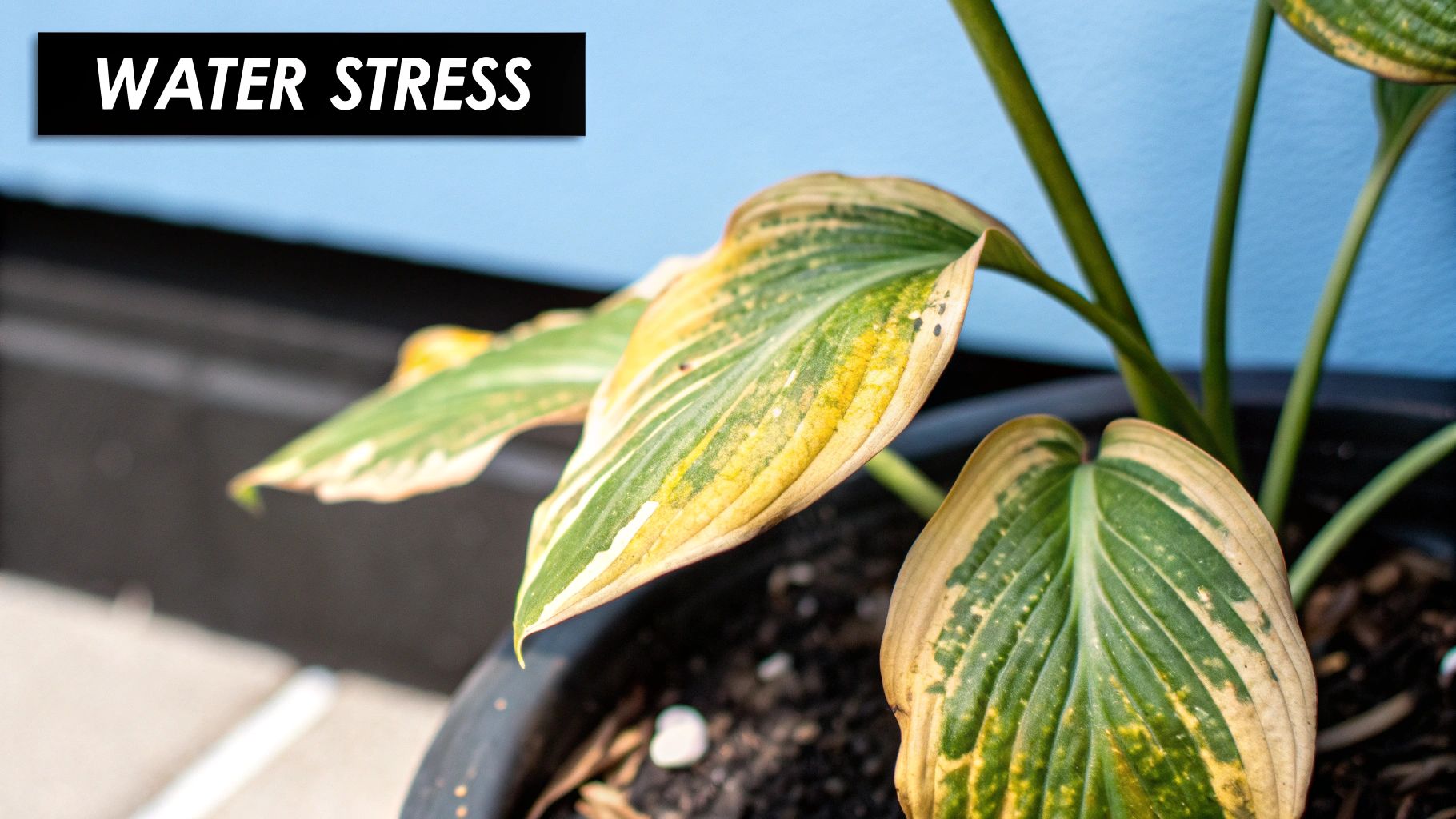
Why Your Pot Material Matters
Just as soil dictates how much water is held, the pot you choose determines how fast that water disappears. This is a crucial detail that many new gardeners overlook, but it has a huge impact on your watering routine.
Terracotta and Clay: These classic, earthy pots are porous. That means air and water can actually pass right through the walls. While this is fantastic for keeping roots healthy and aerated, it also means the soil will dry out significantly faster. A plant in a terracotta pot will almost always need water more often than the exact same plant in a plastic one.
Plastic and Glazed Ceramic: These materials are the opposite—they're non-porous. They create a sealed environment that locks moisture into the soil, preventing it from evaporating through the sides. This makes them a great choice for plants that love to stay consistently moist, or for gardeners who prefer to water a bit less frequently.
Pro Tip: If you have a heavy hand with the watering can, a terracotta pot can be your best friend. Its breathable nature provides a natural buffer against soggy soil, giving you a little extra protection from root rot.
The size of the pot is just as important. A tiny pot contains very little soil, so it will dry out much more quickly than a large pot with a greater soil volume. This is why getting your soil and container choices right from the start is a foundational step in good gardening. You can get more guidance on this in our comprehensive guide to garden planning for beginners.
A Global Perspective On Soil Moisture
This whole idea of soil holding water isn’t just for houseplants; it’s a critical factor for all plant life, everywhere.
On a global scale, the average topsoil can hold about 8.6 cm of water that plants can actually use. But that capacity swings wildly depending on the region. In fact, roughly 30% of the world's vegetated land has a very low water storage capacity of less than 5 cm.
What does this mean for us? It shows that many natural soils have a tough time holding onto water and need more frequent rain or irrigation to sustain life, especially in drier climates. By carefully choosing your potting mix, you're essentially creating a tiny, controlled version of the perfect ecosystem for your specific plant, giving it a much better chance to thrive than it might have in the wild.
Adjusting Your Watering for Light and Seasons
A plant’s need for water isn't a fixed schedule you can set and forget. It’s a living, breathing thing that shifts dramatically with the light it gets and the rhythm of the seasons. Think of a plant sitting in a bright, sunny window as an athlete running a marathon... It’s working hard, using sunlight and water to power photosynthesis and fuel its growth. This high-energy process makes it incredibly thirsty.
Now, take that same plant and move it to a dim corner. It’s more like someone lounging on the couch. Its metabolism slows way down, so it just sips water as needed. Grasping this simple concept is a game-changer, because light exposure is one of the biggest drivers of a plant’s thirst.
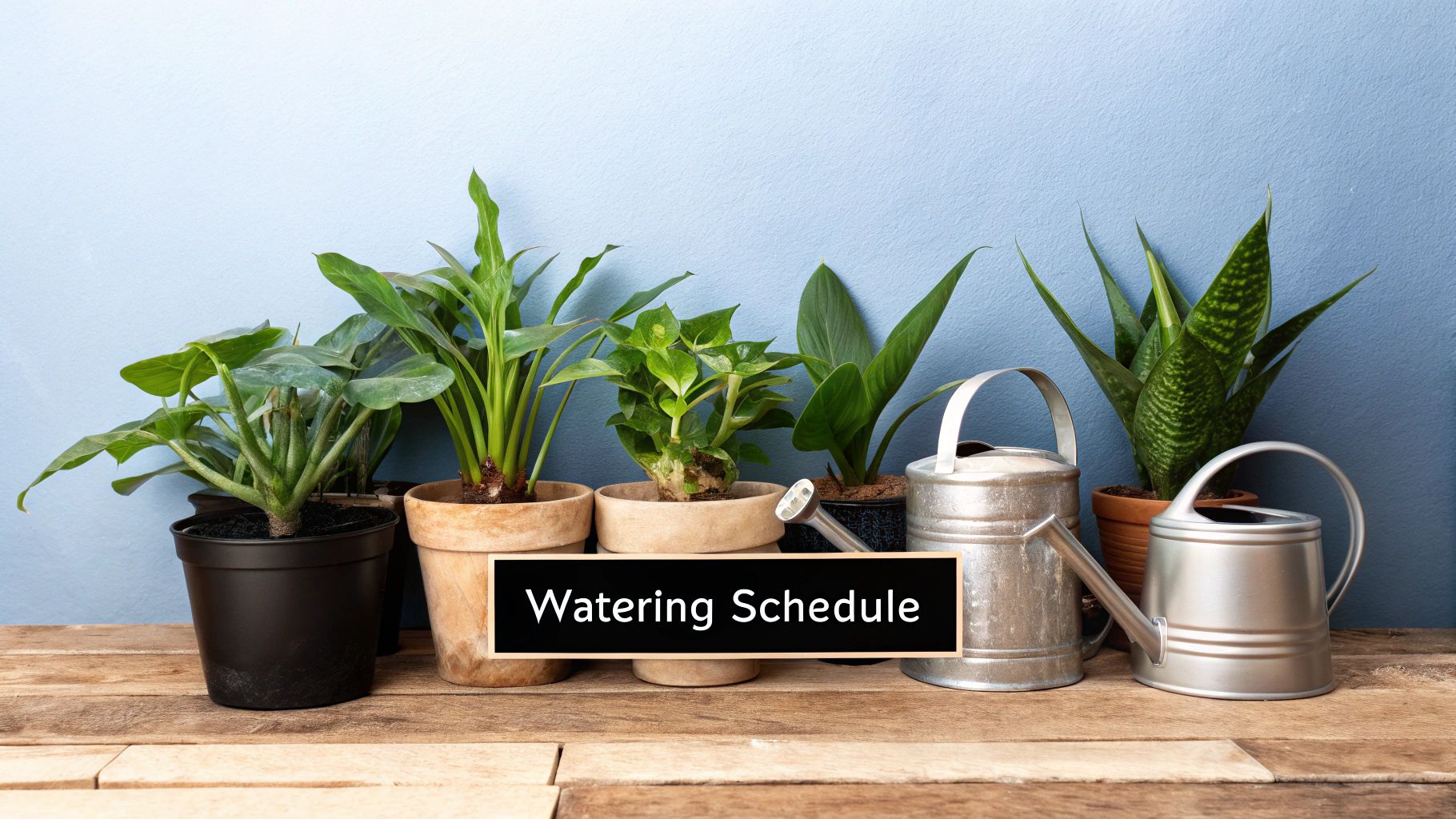
Riding the Wave of the Seasons
Just as sunlight dictates a plant's daily water use, the seasons guide its entire life cycle for the year. Learning to adapt your watering routine to these natural ebbs and flows is what separates a struggling plant parent from a confident one. For most plants, the year breaks down into two main phases.
The Growing Season (Spring and Summer): This is your plant's time to shine. With longer days and more intense sunlight, it’s actively pushing out new leaves, stems, and flowers. All this activity requires a lot more water and nutrients to support its growth spurt. You might find yourself watering a tropical plant twice a week in July, when that same plant only needed a drink every two weeks in January. Even a hardy, drought-tolerant succulent might shift from monthly watering to weekly.
The Dormant Season (Fall and Winter): As the days get shorter and the sunlight weakens, most plants hit the brakes and enter a state of rest, or dormancy. Their growth slows to a crawl, and so does their need for water. This is the most dangerous time of year for well-meaning plant owners, because continuing a summer watering schedule is the fastest way to cause root rot.
Crucial Insight: Overwatering in winter is one of the most common ways that well-intentioned plant parents kill their plants. Always, always scale back your watering frequency as the days get shorter.
Learning to taper your watering is a skill that truly separates novice gardeners from the seasoned pros. For those of us managing outdoor gardens, especially in dry climates, these principles are even more critical. You can find more strategies in our guide covering drought garden tips that don't require daily watering. By simply paying attention to your plant and its environment, you'll learn to give it exactly what it needs, no matter the time of year.

Mastering the Art of Watering for Strong, Healthy Roots
Knowing how often to water is half the battle. Knowing how to water is what wins the war for a thriving plant. The way you deliver that water is just as critical as the schedule you keep, because it directly trains your plant's roots to be either tough and resilient or weak and dependent.
The goal isn't just to get the soil wet—it's to encourage roots to grow deep and strong, anchoring the plant for the long haul.
The single most effective way to do this is with the deep and thorough watering method. Forget giving your plants small, frequent sips. Instead, you want to completely saturate the entire root zone in one go. Pour water slowly and evenly until you see it running freely from the pot’s drainage holes. This ensures every last bit of soil gets hydrated. For top watering, a watering can with a long, narrow spout makes deep watering easier and more precise, getting right to the soil without splashing your plant’s leaves.
Why does this work so well? It forces the roots to stretch downward in search of that deep moisture, creating a robust, extensive network that makes the plant incredibly resilient.
A deep soak is like a full, satisfying meal for your plant. Shallow sips are just unsatisfying snacks. Those constant little drinks keep roots weak and huddled near the surface, leaving the plant vulnerable to the first sign of heat, stress, or a missed watering day.
Top Watering vs. Bottom Watering: Choosing Your Method
Beyond the "deep soak" philosophy, there are two main ways to get the water to the roots. Each has its time and place, and picking the right one can make a world of difference for certain plants.
Top Watering (The Classic Approach) This is what most of us do naturally: pour water directly onto the soil’s surface.
Pros: It’s straightforward, fast, and does a great job of flushing out excess mineral salts that can build up in the soil over time.
Cons: It can get a bit messy, and you run the risk of splashing water on the leaves of sensitive plants like African violets, which can lead to ugly fungal spots.
Bottom Watering (The Soaking Method) This involves setting your plant’s pot in a saucer or tray of water and letting the soil wick moisture up from below.
Pros: It’s a guaranteed way to saturate the entire root ball evenly without a single drop touching the foliage. This is a game-changer for plants prone to crown rot (like snake plants) or those with fuzzy, delicate leaves.
Cons: It takes more patience—usually 15-30 minutes per plant—and because the water moves upward, it doesn’t flush out those accumulated salts.
For most of your houseplants, a good top watering is perfectly fine. But for those species that are fussy about wet leaves or susceptible to rot, mastering the bottom-watering technique will dramatically boost their health and help them live a long, happy life.
Using Technology for Smarter Plant Watering
What if you could take most of the guesswork out of your watering routine? Modern tools are making it easier than ever for home gardeners to give their plants exactly what they need, right when they need it. This isn't about replacing your intuition; it's about giving it a powerful upgrade with real-time data, helping you answer "how often should I water my plants?" with scientific confidence.
Tools That Give You X-Ray Vision
The most accessible tool for any plant owner is a soil moisture meter. Think of it as a translator for your plant’s soil. You simply insert the probe into the pot, and it gives you an instant reading of the moisture level—from dry to moist to wet. It takes the "finger test" to a whole new level, giving you a clear, numerical value to guide your watering decisions. Another fantastic option is using self-watering planters or systems.
For those busy weeks when you can’t check your plants daily, a self-watering planter ensures they stay perfectly hydrated without the risk of overdoing it.
These clever pots have a built-in reservoir that allows the plant to wick up water as needed. This mimics the principles of advanced irrigation by letting the plant dictate its own drinking schedule, which is perfect for busy gardeners or thirsty plants.
Using these tools doesn't just help with watering—it also supports the overall health and nutrition of your plants. Properly hydrated soil allows roots to better absorb nutrients, making your feeding routine more effective. For those focused on growing food, ensuring plants have the right nutrients is just as important as water. You might be interested in our guide on the best natural fertilizer for vegetables. By combining smart watering with good feeding, you create a powerful foundation for a productive garden.
Common Plant Watering Questions Answered
Even when you feel like you've got a handle on the basics, plant care always brings new questions to the surface. Figuring out "how often should I water my plants?" is just the start. Soon you're wondering about the best time of day, the right kind of water, and how to undo mistakes you’ve already made.
Let's clear up some of the most common watering dilemmas. Nailing these details is what turns good plant care into great plant care, giving you the confidence to solve problems before they do real damage.
Can I Use Tap Water for My Plants?
For most common houseplants, yes—regular tap water is perfectly fine. Its convenience is why millions of plant owners use it daily without ever seeing a problem.
However, some sensitive species can have a bad reaction to the chemicals used in municipal water treatment. Plants like Calatheas, Dracaenas, and most carnivorous plants are famously fussy. The chlorine and other minerals in tap water can build up over time, leading to those dreaded brown, crispy leaf tips.
If you have sensitive plants, there's a simple fix: let your tap water sit out overnight in an open container. This gives much of the chlorine a chance to evaporate, making the water much gentler. For your truly delicate plants, sticking with distilled, filtered, or collected rainwater is the safest bet to keep them happy.
What Is the Best Time of Day to Water?
The best time to water nearly any plant, whether it lives inside or out, is in the early morning.
Watering in the morning gives the foliage plenty of time to dry off before evening, which drastically lowers the risk of fungal diseases like powdery mildew. It also makes sure the plant is well-hydrated and ready to handle the heat and light of the day, especially if it’s in a bright, sunny window.
Avoid watering late at night whenever possible. Water that sits on leaves in cool, dark conditions creates the perfect breeding ground for fungus and other pathogens that can quickly harm your plant.
How Do I Know if I Overwatered My Plant?
It’s the number one mistake in plant care, and its symptoms can be tricky. Knowing what to look for is the key to catching it early and saving your plant.
If you think you've been a little too generous with the watering can, check for these classic signs:
Yellowing Leaves: This often starts with the lower leaves first.
Mushy Stems: The base of the plant feels soft, or may even look black and rotted right at the soil line.
A Musty Smell: The soil gives off a damp, swampy odor, which is a sure sign of root decay.
Fungus Gnats: These tiny, annoying flies are drawn to consistently soggy soil—it’s where they love to lay their eggs.
The most confusing sign of all is a plant that looks wilted even when the soil is wet. This is a classic symptom of root rot—the roots are so damaged they can no longer absorb water, so the plant is effectively dying of thirst in a puddle.
If you spot these signs, stop watering immediately. Move the plant to a spot with better air circulation. If it's a severe case, your best move is to gently repot it into fresh, dry soil to give the remaining healthy roots a fighting chance to recover.
At The Grounded Homestead, we know a thriving garden starts with watering wisely. Learning when and how much to water sets your plants up for strong roots and steady growth. If you’re eager to deepen your skills and build a more self-reliant, healthy life, explore our practical guides and tips at The Grounded Homestead. Visit our site to keep growing.



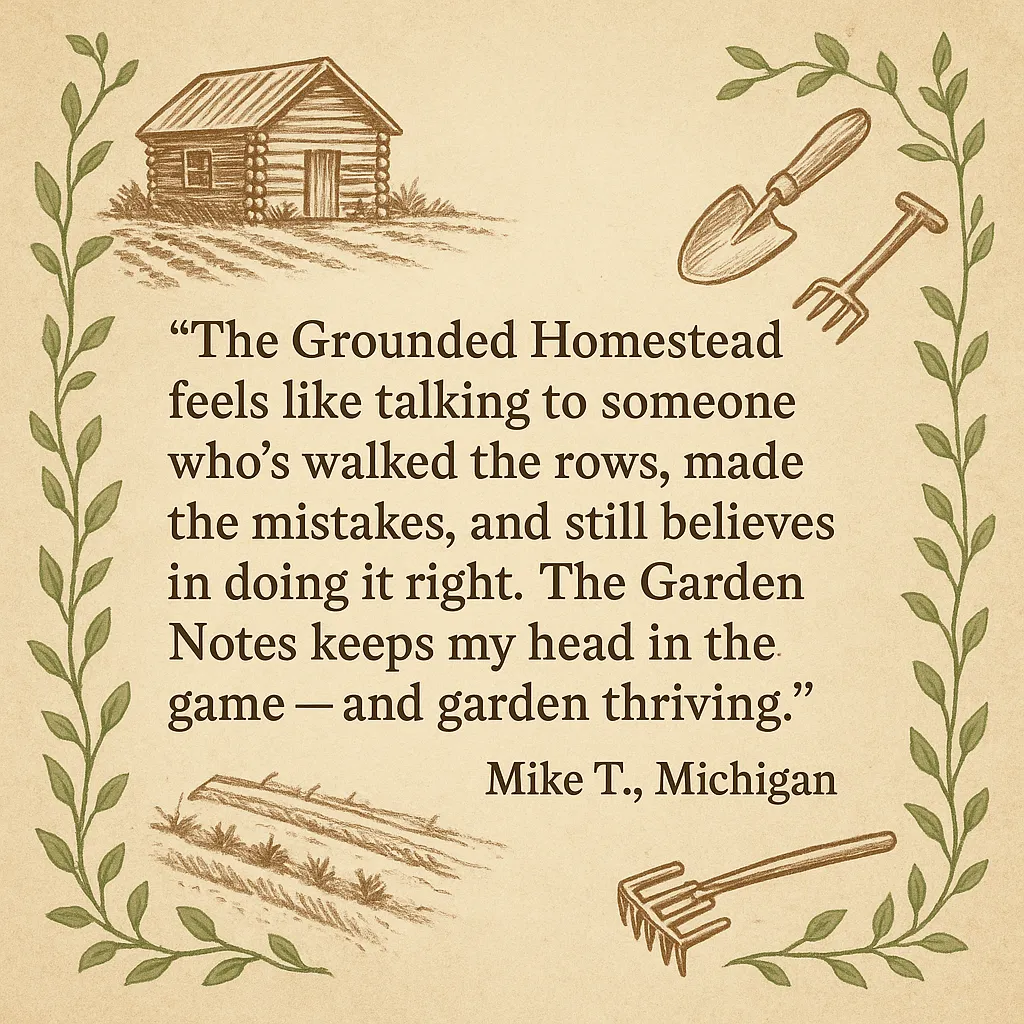
Facebook
Instagram
X
Youtube